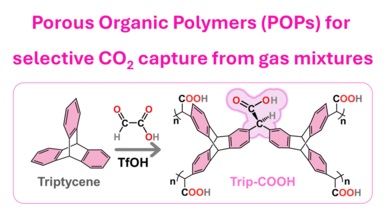
Numerous global challenges involve the manipulation and capture of small gaseous molecules. A significant example is the need to reduce anthropogenic emissions of carbon dioxide (CO2), which harms the climate and the environment. Other issues include the possibility of capturing water vapour (H2O) from the atmosphere, transforming it into purified water accessible to all, and the potential for storing and transporting gases of industrial interest, such as methane (CH4) and hydrogen (H2), in a safer manner. In this context, novel nano-porous materials, endowed with nanometric-sized cavities within their 3D architecture, enable the selective capture and storage of small gas molecules, promoting the development of ad hoc solutions for the aforementioned problems and many others.
Porous polymeric materials, called Porous Organic Polymers (POPs), represent a class of nano-porous materials with great potential for implementation in industrial processes, thanks to their high porosity, chemical and thermal stability, and their cost-effective and high yield synthesis. The selective capture of specific gaseous chemical species depends on the ability to control the size of pores and cavities within their structure and on the presence of functional groups that interact selectively with a particular chemical species. However, controlling these two fundamental aspects is difficult to achieve through traditional preparation methods for these materials.
The research, reported in the article “Direct Integration of Functionalized Bridges by One-Step Superacid-Catalyzed Reaction to Fabricate Porous Polymers for CO2 Capture and Separation” (doi: 10.1002/anie.202507863), published by Angewandte Chemie, Int. Ed. [Wiley, Impact Factor 16.1, 2024 (Clarivate)] led to the development of a new family of functionalized POPs, with finely controlled pore sizes through an innovative synthetic process that overcomes the limitations of traditional preparative approaches. The polymerization method involves the simultaneous cross-linking of aromatic monomers and the controlled decoration of pore surfaces, generating functionalized porous organic polymers with aliphatic carboxylic acid groups. These nanoporous polymers can be further modified by generating ester groups and sodium and lithium carboxylate groups to optimize the selective capture of carbon dioxide over nitrogen. The CO2 capture performances, characterized by good sorption values and an extraordinary selectivity, among the highest ever reported for POPs, enabled the effective capture and separation of CO2 under continuous flow conditions from gas mixtures with compositions similar to those typical of industrial emissions.
The research was led by Professor Silvia Bracco and the researcher Jacopo Perego, with the collaboration of other members of the Nanoporous Materials Research Group from the Department of Materials Science at the University of Milano-Bicocca.
The originality and relevance of the study were highlighted by the publication of the article as a Hot Paper in the Organic Materials section. Moreover, the article was inserted in the collection Hot Topic: Carbon Dioxide (https://chemistry-europe.onlinelibrary.wiley.com/doi/toc/10.1002/(ISSN)1864-564X.hottopic-co2)